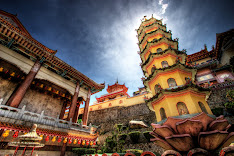Noisy Images
Posted by Kenny in Published Article on Monday, June 6, 2005
Digital noise or the grainy texture you sometimes get on your image has long been the woes of many budding photographers. It results in less than pleasing pictures of speckled images rather than the silky smooth ones that you would most of the time, like to see. Little do some photographers of the digital era know, that at once in analog photography, the equivalent phenomenon, called film grain had such a following that it warranted its own field of interpretation.
WHAT IS FILM GRAIN?
In analog or film photography, film grain is a speckled texture you see on the surface of your picture. This is created by clumps of silver halide which are the light sensitive components on your film. Faster films, which are identified by their higher ISO range (ie ISO 400, ISO 800, ISO 1600) are more sensitive to light and form larger silver clumps resulting in a grainier image.
WHAT IS DIGITAL NOISE?
In digital photography, Digital Noise is the digital equivalent to Film Grain but how they are created is different. The image sensor in a digital camera (CCD or CMOS) converts light into digital information which is stored in the camera’s memory card. Photoelectrons are produced when light hits each individual photosite or pixel on the image sensor. Free electrons are sometimes produced from the heat of the photosites and contaminate the neighboring sensor thus creating digital noise. In the situation of low-lighting, these photosites are affected by electrical signals during the long exposure timing.
Although the effect of digital noise from digital cameras is similar when viewed on a small print, photography purists never regard these two as the same. In fact, digital noise is shunned by many photographers who see this as a poor result of image processing by their digital camera.
Here are a set of pictures with high level of grain effects. The effect of grain adds to the mood to the pictures. |
WHY DOES MY CONSUMER DIGITAL CAMERA SUFFER MORE FROM DIGITAL NOISE THAN A DIGITAL SLR CAMERA?
Consumer digital cameras have a smaller image sensor to convert light into digital information. This means that the photosites on the sensor are closer to each other increasing the occurrence of free electrons. A DSLR has a bigger image sensor with more space in between photosites. This lends to a cleaner and smoother looking image.
This is also another element to consider when you are looking at the latest 8MP digital camera that fits in your front pocket. It does not necessarily mean better quality images but perhaps just higher resolution ones. It may do just as well to get a high quality 3.2MP digital camera with a better output, if you are just going to end up mostly printing 4R prints and the occasional 8R. But, image sensors on digital cameras are improving greatly and I could be proven wrong with many of the new digicam in the market nowadays. Do consider all elements when getting your next digital camera.
WHAT IS THE EFFECT OF FILM GRAIN ON AN IMAGE?
Black and White films in analog photography are the fastest ranging up to ISO1600 and ISO3200. At this level, grain is extremely high. One of the effects it has on the picture is creating a picture that has a lot of mood and atmosphere. This sometimes helps to improve a scene that is otherwise lacking in interesting features.
Grain in a black and white picture also results in a punchier and sometimes a more dramatic picture as it as a shallower contrast range and outlines are more clearly defined. Bear in mind faster films are also less saturated and are not as sharp.
Faster films or ISO setting allows you to use a faster shutter speed setting in many situations where lighting is low and using your camera’s flash will kill the ambience of the scene.
It is still best to set your camera on the lowest ISO setting most of the time and then add the effect of grain into your picture as you see fit. At least this way, you can adjust any changes that have been applied to your image.

